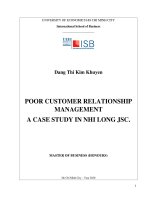tiểu luận working assignment 1 course customer relationship management topic crm models
Bạn đang xem bản rút gọn của tài liệu. Xem và tải ngay bản đầy đủ của tài liệu tại đây (1.34 MB, 16 trang )
<span class="text_page_counter">Trang 1</span><div class="page_container" data-page="1">
Đà Nẵng, tháng 1 năm 2024
</div><span class="text_page_counter">Trang 2</span><div class="page_container" data-page="2">1
<b>DUTY CHART </b>
Phạm Hoàn Vĩnh Liêm <sup>Member </sup> <sup>The Five-Process Model of </sup><sub>PAYNE and FROW </sub>
</div><span class="text_page_counter">Trang 3</span><div class="page_container" data-page="3"><b>2.2. The process of the CRM Value Chain ... 7 </b>
<b>2.3. Benefits of using the CRM Value Chain Model ... 8 </b>
<b>3. The SCHEMA Model ... 9 </b>
<b>3.1.Introduction ... 9 </b>
<b>3.2. Four key foundations: ... 10 </b>
<b>3.3. Five enablers of good customer management: ... 10 </b>
<b>4. The Five-Process Model of PAYNE and FROW ... 10 </b>
</div><span class="text_page_counter">Trang 4</span><div class="page_container" data-page="4"><b>LIST OF FIGURES </b>
Figure 1: The IDIC Model ... 4
Figure 2 The CRM Value Chain: ... 6
Figure 3: The SCHEMA model of customer management ... 9
Figure 4: The Five-Process Model of PAYNE and FROW ... 13
<b>LIST OF TABLES </b>Table 1: Tools and processes in each stages ... 8
<b>Too long to read onyour phone? Save to</b>
read later on yourcomputer
Save to a Studylist
</div><span class="text_page_counter">Trang 5</span><div class="page_container" data-page="5">- Specify (Identify): Identify customer characteristics and actions
- Differentiate: Classify customers into different groups. Each group shares common characteristics based on identified factors.
- Interact: Interact with each customer group appropriately and effectively. - Customize: Offer products, services and experiences suitable for each customer
group.
Figure 1: The IDIC Model
<b>1.2. Applying IDIC Model to CRM </b>
- Identify who the business's customers are?
</div><span class="text_page_counter">Trang 6</span><div class="page_container" data-page="6">5
Collect all data from users to analyze and identify action characteristics. As customers continue to stress with businesses, some information can be collected such as demographics, purchase history, habits, reviews, etc.
⇒ The purpose of determining customer actions is created, the customer database is completed. Know who the customers are, what they want.
- How are customers different?
Based on the collected data, identify differences between multiple customer groups. What characteristics will make the difference? Different needs, habits and other demographic factors influence purchasing decisions.
⇒ The goals of different business enterprises customize sales and marketing strategies based on the characteristics of each customer group.
- How should businesses interact with customers?
There are many communication channels that businesses can use to interact with customers such as via email, phone, fake advertising, electronic advertising... The goal of interacting with customers is to create an environment Be proactive and professional to make customers feel cared for and satisfied, creating a connection between customers and the business.
- Personalize products and services suitable for customers
The goal of customization is to create a personalized product and experience that feels responsive to customers. To some extent, personalization will increase a business's customer loyalty rate. Ultimately helps increase sales and profits of sustainable businesses.
<b>1.3. Benefits of IDIC in CRM</b>
- Identify and recognize the group's customer criteria. Through the process of analyzing and collecting data, businesses can better understand the characteristics and needs of customers, thereby classifying and grouping into similar objects. - Help businesses create positive interactions with customers to build good
relationships and increase customer satisfaction.
</div><span class="text_page_counter">Trang 7</span><div class="page_container" data-page="7">6
- Provide customized solutions to meet customer feedback and expectations. Customization helps create unique value and enhance customer satisfaction, thereby creating a competitive and exclusive advantage for businesses.
<b>2. The CRM Value Chain 2.1.Introduction</b>
The CRM Value Chain depicts our contemporary understanding of CRM as a set of strategic management practices that aim to drive profit performance. The focus of the CRM Value Chain is on the profitability of customers, not the performance of brands or gross margins. CRM offers a customer-focussed way of doing business and is based on the notion that the primary purpose of a business is to create and keep profitable customers.
The purpose of the CRM value chain: The ultimate purpose of the CRM value chain process is to ensure that the company builds long-term mutually-beneficial relationships with it’s strategically - significant customers. Not all customers are strategically significant. The CRM Value Chain includes steps: 5
- Customer portfolio analysis (CPA) - Customer intimacy
- Network development - Value proposition development - Managing the relationship
Figure 2 The CRM Value Chain:
</div><span class="text_page_counter">Trang 8</span><div class="page_container" data-page="8">7
<b>2.2. The process of the CRM Value Chain </b>
- Customer portfolio analysis (CPA)
The CPA approach involves examining the customer base to pinpoint specific customers who can be approached with diverse value propositions. This process utilizes data about customers and the market to make informed decisions about which customers to focus on. Companies seek to categorize their customer base into segments, aiming to identify the most lucrative groups. They analyze which customers are spending significantly on their products and services. The ultimate objective for these companies is to establish their ideal target customer group. By assessing and categorizing their clients, they aim to identify those groups that are most appealing for business transactions, based on their set criteria for a desirable customer.
- Customer intimacy
The subsequent phase requires the business to familiarize itself with the chosen customer groups or individuals, constructing a customer database that is readily available to all stakeholders influencing customer perceptions and actions. This step focuses on understanding each customer individually. After identifying the target segments, companies aim to gain deep insights into the individuals within these segments, striving to understand them more thoroughly than their competitors do. Achieving customer intimacy entails a comprehensive understanding of the customers and their specific needs.
- Network development
The third step in this process entails establishing a robust network of relationships with employees, suppliers, partners, and investors, all of whom are aligned with the needs of the selected customer groups.
- Value proposition development
In the fourth step, this network collaboratively develops value propositions that benefit both the customer and the company. This involves either building or acquiring resources necessary to create and deliver value to customers.
- Managing the relationship
</div><span class="text_page_counter">Trang 9</span><div class="page_container" data-page="9">8
The fifth and final step focuses on managing the customer relationship. This management includes implementing Customer Relationship Management (CRM) strategies for acquiring and retaining customers and enhancing their value to the company.
➔ These steps are not static but iterative and reflexive. This means that the five-step process is ongoing and repetitive, rather than a one-off procedure leading to a permanently effective strategy.
➔ Data plays a crucial role across all five stages of the CRM Value Chain.
At each stage of the value chain there are concepts, tools and processes to help create and implement successful strategy:
Customer Portfolio
Analysis
Customer Intimacy
Network Development
Value Proposition Development
Manage The Relationship - Market
segmentation - Sales forecasting - ABC - Life-time value - Customer analysis toolkit
- Customer database development - Internal data - Data enhancement - Data warehousing - Data mining - Benchmarking - Privacy - Database technology and software
- Network management - Internal buy-in
- External network - Network position - E-commerce - EDI/Extranets/ Portals
- Sources of customer value - Customer experience - Process reengineering - People issues - Technology enablement
- Customer acquisition - Customer retention - Customer development - Organisation design - Metrics
Table 1 Tools and processes in each stages:
<b>2.3. Benefits of using the CRM Value Chain Model</b>
- Optimize Customer Relationship Management: This helps create strong relationships with customers and increase their loyalty. Customers feel cared for and valued.
- Create an Outstanding Customer Experience: Customers will feel more satisfied with your services and products, which helps create loyalty and retention. - Boost Marketing Performance: By optimizing marketing and customer engagement,
businesses can achieve better performance in attracting and retaining customers.
</div><span class="text_page_counter">Trang 10</span><div class="page_container" data-page="10">9
- Building Long-Term Relationships: The CRM value chain helps build long-term and honest relationships with customers. This can lead to loyalty and long-term growth, helping businesses maintain and expand their market.
<b>3. The SCHEMA Model 3.1.Introduction</b>
The SCHEMA model is a commercial property developed as a benchmarking tool by TCF. The model, as shown in the following figure, aims to help companies strike an optimal balance between customer engagement and profitability. The model proposes a key financial goal for customer management – the achievement of sustainable incremental profitability. This goal is achieved when the identified foundations enable the successful execution of strategies designed to win, keep and develop customers cost-effectively.
Figure 3: The SCHEMA model of customer management
</div><span class="text_page_counter">Trang 11</span><div class="page_container" data-page="11">10
<b>3.2. Four key foundations: </b>
The model identifies four key foundations that underpin successful customer engagement: - Direction and leadership (e.g. clarity of strategy, cross-functional ownership,
budgets, measurement).
- IT and data management capabilities. - Organizational culture (ways of working). - Competencies of people.
<b>3.3. Five enablers of good customer management: </b>
The model identifies five enablers of good customer management:
- The deep customer insight that is necessary for well-targeted marketing, selling and service.
- The alignment of brand positioning with customer experience.
- The integration of channels and media and the way content is created and used. - The agility and workflow required to support real-time engagement (including
compliance and decision-making).
- The activities that get measured will drive action by management and front-line staff.
<b>4. The Five-Process Model of PAYNE and FROW4.1.Introduction</b>
Adrian Payne and Pennie Frow introduced the Five Processes Model, aiming to enhance Customer Relationship Management (CRM) by prioritizing customer acquisition and retention. This model delineates key processes essential for building and sustaining strong relationships with customers.The model discusses the relevance of various processes.
<b>4.2. The process </b>
<b>Strategy development in Payne’s Five Processes model </b>
The process of strategy development is divided into two distinct components: business strategy and customer strategy.
In the realm of business strategy, an organization must develop a vision related to its offerings, with the aim of establishing itself as a pivotal player within the industry. This model posits that:
</div><span class="text_page_counter">Trang 12</span><div class="page_container" data-page="12"><b>Value creation process </b>
The value creation process of Payne’s Five Processes model involves identifying the value of a customer to the business and the value of a business to the customer. The business needs to understand which customers are valuable through the process of value proposition and value assessment. The business can receive value from retention economics (Reduced Churn, Personalized Incentives, Predictive Analytics) and acquisition economics (Targeted Value Propositions, Reduced Acquisition Cost, Brand Advocates)
The value creation process in Payne's Five Processes model isn't just about identifying existing value. Rather, it's a dynamic transformation, fueled by insights from the strategy development stage. This transformation extracts raw value and refines it into compelling propositions that resonate with customers and drive mutually beneficial results.
Payne’s Five Processes model explains that there are 3 aspects of effective value creation. Firstly, the organization needs to determine which processes can create value for the customer. Secondly, identify customers who can add value to the organization. Thirdly, identify how to maximize value in desirable customer segments for a successful exchange of values.
* Value Co-creation:
+ Joint Problem Solving: This involves collaborating with customers to identify and solve problems together. This might involve product customization, feedback incorporation, or personalized service offerings.
</div><span class="text_page_counter">Trang 13</span><div class="page_container" data-page="13">12
+ Partnership and Alliance: Building strategic partnerships with other organizations can enhance the value proposition for both the company and its customers. This can involve co-branded products, shared services, or loyalty programs.
Customer segmentation can have a significant impact on CLV because it allows company to identify and target high-value customers more effectively. By dividing customer base into smaller groups based on shared characteristics, business can gain a deeper understanding of what motivates each segment to make purchases and what their specific needs and preferences are.
<b>Multichannel integration process </b>
Payne and Frow consider the multichannel integration process as an important process as it works on inputs from value creation processes and business strategy. It involves converting the insights from these processes to outputs in value-adding activities. The multi-channel intergration processes are sales force, outlets, direct markeitng, call center/telephone, electronic/mobile commerce, social media). This process suggests the business conduct tasks to engage customers, understand their perspective and retain them for a longer duration. It helps businesses to focus on making decisions that integrate all channels and ensure the customer experience is positive, called intergrated channel managemant. Moreover, feedback from this process needs to be taken into account to further evaluate both strategy and value proposition. This helps in better CRM implementation for a greater success of the organization.
<b>Performance assessment process </b>
Performance assessment is very important to understand how well the value proposition of the business is and whether the customer’s interest is leading to better business performance. Payne and Frow suggest an understanding of the performance through shareholder value, customer engagement scenario, profit margins, and returns through dividends. According to Payne’s Five Processes model, performance assessment of business should also include monitoring of customer satisfaction, standard assessment and analysis of Key Performance Indicators (KPIs). Assessing performance includes employee, customer, shareholder and cost reduction.
</div><span class="text_page_counter">Trang 14</span><div class="page_container" data-page="14">13
Figure 4: The Five-Process Model of PAYNE and FROW
<b>Information management or analytical process </b>
Information management is the analytical part of the model. It is a support to the other processes. Payne’s Five Process model suggests collecting, organizing, and using information related to customers helps with insights on consumer behaviour. It helps businesses to create appropriate marketing responses and improve value propositions. To manage such activities, businesses should develop a data repository system with data analysis tools, IT systems, front office applications, back-office applications. These applications can help keep the CRM process a comprehensive one for quantitative and qualitative measurement of market competitiveness.
<b>4.3. Application of Payne’s Five Process model of CRM in an e-commerce business </b>
- Drive Strategic Decisions: Data analysis informs the development of targeted value propositions, allowing e-retailers to engage specific customer segments with offerings like discounts, loyalty programs, and prioritized shipping.
- Refine the Customer Journey: Multi-channel integration connects data from reviews, customer service, email interactions, and return policies, creating a holistic view of
</div>








